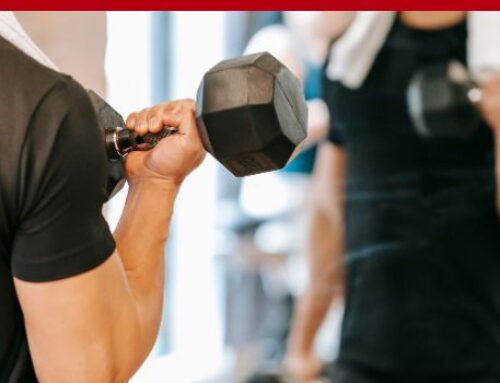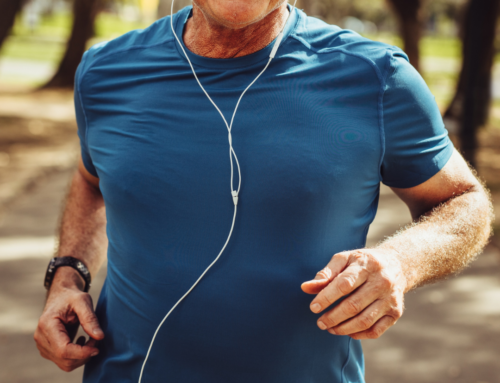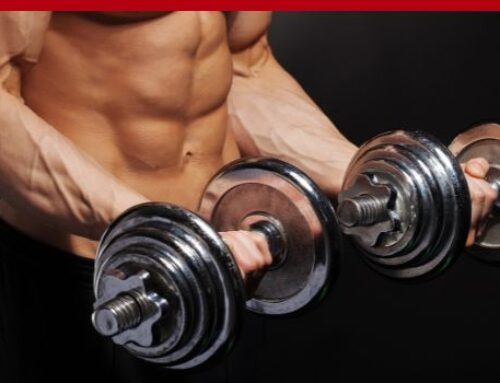
523: 3 Habits I Used to Achieve 10% Body Fat without Giving Up My Favorite Foods with Ted Ryce
Reaching 10% body fat or less through very restrictive diets and excruciating workouts is possible; in all honesty, it is a reasonably effective way to do it.
However, this approach to losing fat is not sustainable for several reasons. If you are not an elite athlete, who goes through weight cuts or restrictive diets toward scheduled competition objectives, you’ll end up derailing from your meal plan.
It happens similarly with extreme workouts; they weren’t designed for the long term, and with time, you’ll get either injured or incapable of dealing with the chronic joint pain
So, is there a way to reach 10% body fat sustainably in the long run?
In this Ted Talk, Ted reveals the three habits he used to reach 10% body fat, eating the foods he enjoys most and without agonizing and exhausting workouts.
He explains the importance of tracking and collecting data about our eating, sleep, and light cardio routines to modify and adjust them, guarantee maximum gains and accelerate fat burn.
By incorporating these three simple yet powerful habits, you’ll be able to not only reduce your body fat to 10% or less but, most importantly, enjoy those results in the long run. Listen Now!
You’ll learn:
- About Ted’s previous experiences reaching 10% body fat and what made his former approach unsustainable in the long run
- his is the most important thing you should do to lose fat
- The reason why restrictive diets are so hard to maintain in the long term
- The not-so-known connection between sleep quality and hunger management
- The type of exercise that will help you make your fat loss journey feel effortless
- And much more…
Related Episodes:
Links Mentioned:
Schedule a 15 min strategy call
Do You Need Help Creating A Lean Energetic Body And Still Enjoy Life?
We help successful entrepreneurs, executives, and other high-performers burn fat, transform their bodies, and grow successful businesses while enjoying their social life, vacations, and lifestyle.
If you’re ready to have the body you deserve, look and feel younger, and say goodbye to time-consuming workouts and crazy diets, we can help you.
Click Here To Schedule Your 15-Min Strategy Call!
Or go to legendarylifeprogram.com/free to watch my FREE Body Breakthrough Masterclass.
Podcast Transcription: 3 Habits I Used to Achieve 10% Body Fat without Giving Up My Favorite Foods
Ted Ryce: Today I want to talk about the three habits I use to achieve 10% body fat without hard workouts or giving up my favorite foods. So, I used to believe that strict diets and grueling workouts was the way to achieve a low body fat percentage.
And I got to a low body fat percentage in my late 20s—well, actually for most of my 20s, but I really got lean and fit and strong in my late 20s, doing a combination of low carb diets and jiu-jitsu and weightlifting, but I felt really beat up as a result. And today I want to talk about how I do this with habits that feel effortless.
So, what is up, my friend? And welcome back to the show. I'm your host, Ted Ryce, coach to entrepreneurs, executives and other high-performing professionals. And let's dive right in. As I was talking about few seconds ago, I got very lean in my late 20s and early 30s, but it felt like so much work. The workouts I was doing the jiu-jitsu and the weightlifting—the weightlifting was okay, but the jiu-jitsu was beating up my body badly.
And it reminds me of some of the clients that I've talked to where they were doing triathlons, but needed a knee surgery, they were doing marathons, but suffering from hip pain, you know, so many problems result as a consequence of doing really hard workouts. And what I've learned is this, they're unsustainable.
So, if you're exercising right now, I hope this is resonating with you. Because if you're feeling your joints, you’ve got to ask yourself, like I did, if I'm in my—let's say, I'm 45 now, if I'm 50 now, if I'm 55 now, and I'm in this much pain with my workouts, how's it going to be in five years? How's it going to be in 10 years? It's not going to get better; it's going to get worse.
And for me when I was in my 30s and feeling this way, man, I was scared a little bit. I'm like, how am I going to do this? How am I going to be fit? Am I just going to get fat, and I'm going to get fat, and I have these injuries that I've gotten from these strenuous workouts.
So it's going to be a double whammy, I'm not going to be exercising as much because my joints hurt. And then I'm going to get fat, because I'm not exercising. And then I just saw my health and really, my life, go down the toilet. Because once you're in shape, getting out of shape is kind of like being a millionaire and then going broke.
It's one thing to start broke and work your way up, which I've done too. I'm not a millionaire, by the way, in case you're wondering, but business is going well. But if I had to lose it all right now, I believe I could build it back. But let's just say I couldn't for some reason, man, that would really be hard.
And that's what going from very fit to very out of shape is like. Going from fit to out of shape is just not something I want to even think about. And as a result of that experience, where I just felt like what I was doing was not sustainable. I had to figure out okay, well, what is sustainable here?
If a strict diet isn't going to work for me, then what do I do instead? If during this hard workout where my knees are aching, my shoulder hurts, if that's not sustainable, if I can't keep doing this, how can I stay in great shape without the injuries? Because going back to out of shape is just unacceptable for me.
And that's what I want to share with you today. So, the first habit is tracking calories. Yes, I know I talk about this a lot. But it changed the game for me. tracking calories taught me that the caloric content of food was the most important nutrition principle for fat loss.
And then all of a sudden, I was losing fat while eating pizza, brownies, and ice cream a few times a week, as long as I kept my total calories in check. This is what I teach my clients to do. And it's so much easier to lose fat when you can eat the foods that you want.
And in case you're judging me right now and say, “Oh, that's not healthy. Ted, you shouldn't eat any sugar, you shouldn't want brownies, you shouldn't eat ice cream.” Yeah, in a perfect world, which doesn't exist, on the perfect plan, again, which doesn't exist, we'd be perfect people, which is not a thing. Nobody is perfect. And we’d eat perfectly, and we wouldn't have any sugar, we wouldn't need sweets.
But the reality is, we're all built a certain way. And if you don't need those things in your life, I'm not telling you, hey, you should eat brownies and pizza because calories is the most important thing and you can eat them and keep your calories in check, and that's all there is to it. That's not what I'm saying.
I'm saying, if you view yourself as a person who's less than perfect, like me, and you have a tendency, you know, I've had people tell me, “Hey, you may be lean, but you got a fat mind.” You ever been told that before? That's what I get told. And it's true.
And what they mean is this: I have a strong desire to eat delicious food, especially the sweets. I wouldn't say especially the sweets. But I have a strong desire for sweets, as much as I have a strong desire to eat pizza. Not a big fan of burgers and french fries, to be honest. But I like ice cream. I like pizza. I like these things. And I've tried being strict and keeping them out of my life. And what happens is I end up binging.
So, if you're a person, and you feel like you've got to be so strict, but you end up falling off the wagon, I'm never off the wagon anymore. I don't feel like I break down and cheat. I feel like I just live my life. And I watch my calories. And I track them. And I keep them in check.
And I'll even tell you this. I am tracking right now for a couple reasons. One, I want to get super lean, back to my “veins on abs” lean that I've mentioned if you've been listening throughout the year, the past few years, but I also do it because my clients track and I want them to see when they check in in My Fitness Pal, they see me tracking all the time.
And to be honest, it's like tracking is really easy for me now, it just gets easy, just like everything that you do. It's kind of sucks when you first started, but then it gets easy. And I'll even say this, even though I've shared this story before, when I worked with my coach Eric to get lean in 2019—get lean in 2019, rhyming today—I didn't like tracking. The first three days was really annoying.
Kind of like when you get a new iPhone. When I got the new iPhone, you know when they switched from the button to not having the button. I don't know about you. But I was like pissed off. I was like, “Man, this sucks. There's no button, I just want to press the button, the button was so easy.”
And then after like, maybe 30 minutes or an hour, I'm like, “Oh my gosh, this is so much more intuitive, so much easier to use.” I'm so glad they got rid of the button because this is so much better. And I don't have to worry about the button breaking down or any of that stuff. This is so much better.
And the same thing was true with tracking. I was really annoyed with it for three days. And then after that, I'm like, “Oh my gosh, this is easy. It remembers all the foods I eat so I don't have to go searching for them all the time. It's really easy. And it allows me to be imperfect. But to still get great results, not even good results, and even lose a couple pounds. No.
If you look at me right now, I've got veins on my shoulders, I don't have the veins on abs. I'm working on it, okay, but I'm so lean. And I'm not saying this as a brag. I'm saying this because I really struggled with this. And I struggle with the types of foods that I'm drawn to eating. But still, as imperfect as I am, I'm still able to get great results.
And this is the shift that I help my clients with as well. They have this same experience, where they don't have to…If you want to be super clean eating, you can do that if you want to fit in some wine, you can do that. If you want to fit in some dessert, you can do that. It's so much easier to lose fat and maintain it when you can eat the foods you want.
And you feel like there's nothing…In my fat loss coaching group, certainly, I put people on a strict approach at the beginning just to kind of get them quick results. People lose four to six pounds in the first 10 days and they just really get them dialed in.
But after that, we remove the restrictions. If you want to eat pizza and brownies and all the shit I eat, you can do it. So, tracking calories was a game changer. And it's just a habit that I do now. And I don't even have to do it. I could still be lean without it.
But to get veins on your abs lean, like I'm working towards right now. Although, albeit slowly, because there's been a lot of socializing recently, but I'm still making progress. Tracking my calories helps me do that. It helps my clients do that as well.
Habit number two, tracking sleep. Here's the thing. Fat loss is mostly about hunger management. Certainly, it's about what I just talked about, understanding the calorie content of foods, understanding which foods have a lot of calories but don't fill you up, which foods have very few calories and fill you up.
But the other part is just, if you can not be hungry, it's easier to not eat things, right? Why do you eat? Because you're hungry. Why do you don't eat? Why am I not eating right now? Because I'm not hungry. I already ate. Actually, I'm a little hungry right now, because it's been a couple hours.
But I wasn't hungry after I ate breakfast. Now it's lunchtime, past lunchtime. Time to eat. But what I noticed was when I sleep poorly, I was even more hungry than usual and I crave sweets more than usual. I always like something delicious, right? I like to order dessert, especially if it's in a good restaurant.
I've been going to this pizza restaurant here in Brasilia, Brazil, it's called Fratello, incredible pizza, some of the best pizza I've had in the world. Now, I haven't been to Italy. But way better than anything I've had in Miami, except for the black truffle pizza at Soho House, that was insanely good pizza as well.
But I would even say this pizza is on the same level as that or real close to it. And so I want those things more when I haven't slept well. And it makes it hard to stay on track. So, what I started doing is I got an Oura ring. Now, I have no affiliation with them and I don't have a promo code or anything like that. But I will tell you this. And I even have some issues with the ring, of course, but ultimately, will I keep using mine? Will I keep buying?
Well, it depends on—I don’t want to go down to too much of a tangent here, but it is worth having an Oura Ring right now. I don't know how the company is going to evolve in the future. But right now, it's worth having an Oura Ring. Why? Because you read all that stuff that people say, even I've said to you, right, go to sleep and wake up at the same time, dim the lights at night, get natural light in the morning, I do all that stuff.
But the thing that has helped me the most to pinpoint the things that matter the most for my sleep quality was what I learned through tracking my sleep with an Oura Ring. And I have actionable items, I can take actions based on the data. That's what I love about it. If I see my resting heart rate creeping up, I know I’ve got to do more cardio and less strength training.
If I see that I'm going to bed too late, I know that I have to dial in my sleep timing, and I do it. I'm imperfect with it, but I do it. And I wouldn't know these trends if I didn't look at the data. And just like when I want to see what does well on Twitter, because I'm on there a lot, I check the data, I check the analytics—which of the tweets that I put out, which of the threads that I put out, what content that I put up on Twitter that perform the best?
And I can see that that's the beauty of data. And so when I look at the nights that I slept the best, I can see what I did. When did I go to bed? How long did it take me to fall asleep? I can look at all this stuff. And it tells me, and that is the power of tracking. It's a game changer. And it's the number one piece of advice.
It's like, what's the number one piece of advice you can tell me, Ted? I don't sleep well and I want to sleep better, what's the number one piece of advice you can give me? Track your sleep. Now I use an Oura. It's the only thing I've ever used to track my sleep. I know other...
I know the Garmin. I’ve got a client who tracks his sleep with Garmin. He likes that. I can't talk about it, because I haven't used it. But the Oura is super solid. So, tracking your sleep is the number one piece of advice I can give you. The next habit is tracking daily steps.
I used to think that I burned a ton of calories with hard workouts and the reality is this: you don't burn as much as you think. You think you're crushing it, but what you're really doing is you're burning some calories. And one slice of pizza can undo 30 minutes of exercise. How many slices of pizza can you eat in 30 minutes?
I ate three last night. It's like 700-ish calories. And what am I going to do? Go work out for 90 minutes to burn that off? No way. But what I have learned is that if I just shoot for 10,000 steps, not only is it easier on my joints, but it's better for my schedule.
So, if I want to go do cardio in the gym, I'll go do it and I'll count the steps. But if I don't do cardio, I just make sure I walk 10,000 steps and you can pace around your room. You can get on a phone call and start walking around, pacing around your house—or I say room because I’m in an Airbnb apartment. It's actually in a hotel here.
It's a nice hotel. Nice place modern and with blackout blinds, which is the number one reason I'm staying in this place as opposed to some of the other places that are bigger, but I can pace around on a phone call in here and get more steps in and if I do that I get great results. And it's not that hard to do.
And I use Oura Ring to also track my daily steps, but you could use a Fitbit, you could use your Apple Watch, you could use whatever. But I would recommend that you track your daily steps and start shooting for a number. And if you're not hitting 10, try bumping up whatever it is right now for 2000 steps, and test it for a week to see if you don't notice a difference.
And here's a bit of a bonus tip here, although we're talking about habits, the bonus tip is this: Fat loss isn't about nutrition alone. We hear that, but what I've learned from actually doing this with myself and with clients for 23 years is that you’ve got to find the right combination for a person, an individual, between the calories they eat and the calories they burn.
Some people like to work out more, some people like to walk more, some people like to eat less, and not do so much exercise. And what I want you to take away from this is by tracking calories, tracking your sleep and tracking your steps, you can figure out what works for you. And that is actually what I end up teaching my clients.
I'm not sitting there telling them what to do. I'm saying, hey, here's what's optimal. How can we create these habits in your life? Like, which one of these habits should we work on first? Which ones do you feel like you can keep doing? And you don't necessarily have to work with me to figure out your own habits.
By tracking you can start to learn what works for you. And that is so powerful, so, so powerful. So that is it for me today. I hope you enjoyed today's episode and these more recent episodes where they're a little shorter, more to the point. And I would also ask you, what is one action you can take from listening to this episode today? Because knowledge isn't learning; knowledge and applying is learning.
So how can you apply what you've learned today to get better results? And if you want to share that with me on Twitter, I'd love to hear from you. When you're on Twitter, hit me up Ted Ryce. So that's @ted_ryce. We'd love to hear from you. Hope you enjoy this. Have an amazing week, and I'll speak to you soon.
Sign up to receive email updates
Enter your name and email address below and I'll send you periodic updates about the podcast.
Similar Episodes you may like
About the Show
The Legendary Life is a fun and enlightening look at health fitness, nutrition, biohacking, fat loss, anti-aging, and cutting-edge health advice from celebrity fitness trainer Ted Ryce. Ted’s clientele consists of celebrities, including Richard Branson, Ricky Martin, and Robert Downey Jr., CEOs of multimillion-dollar companies, and other high performers.
He breaks down countless health topics and provides science-backed solutions and the most effective, uncommon strategies to rapidly lose weight, improve your health, and upgrade your physical and mental performance, so you can live the life you deserve.
He breaks it down by providing science-based information so you can clear up the confusion and finally lose weight, fight disease, and live a longer, healthier life.
No guru. No fluff. And no preaching of generic fitness advice here. Along the way, Ted shares his own journey of how he turned great tragedy and loss into success and hope.
Now, his mission is to empower you with the tools and the knowledge you need to live your best life. New episodes every Monday and Friday.





